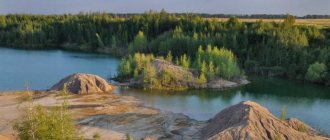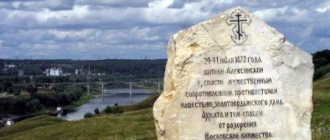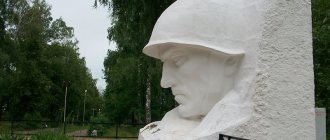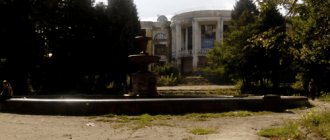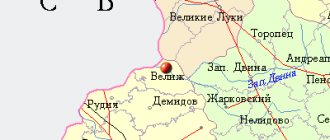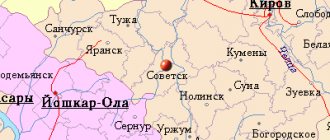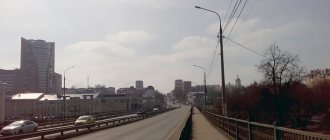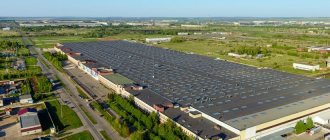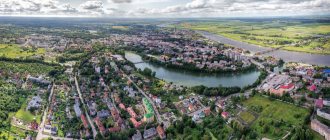History[edit]
The construction of the settlement during the construction of the Shchekinskaya State District Power Plant near the village of Kryukovka began in 1947. The first 7 buildings housed the construction department, the directorate of the State District Power Plant, a telephone exchange, a canteen and a store.
On October 26, 1949, he was classified as a worker and received the name Soviet.
On October 31, 1954, the village of Sovetsky was reorganized into the city of regional subordination of Sovetsk. The village of Upinsky is included within the city limits.
Since 2006, it has been part of the municipal formation “Sovetsk City” as part of the Shchekinsky district.
Residents of a house in the city of Sovetsk, Tula region, blame each other for turning off the heating
Residents of a house with two owners in the city of Sovetsk, Shchekinsky district, have been waging an internecine war for almost ten years. Neighbors cannot come to a common decision on the installation of a heating system in their home. The residents of the house located on Pionersky Proezd told the Tula News Service about this.
“I have to live in the kitchen, and it’s zero degrees in the house.”
According to Evgeniy Korobov, who lives in apartment No. 1, his neighbor Olga G. unauthorizedly changed the heating system, which led to a disruption in the heat supply to his part of the house. He sued his neighbor. In 2017, the Shchekinsky District Court, based on the conclusion of a forensic examination, declared the reconstruction of the communal heating system in apartment No. 2 illegal and decided to return it to its previous state. However, no one has done this in 4.5 years.
“The judge decided that it was necessary to replace the existing plastic heating pipe with a metal one, but the neighbors did not do this. I had to cut it off, pushing the residents of the second part of the house to dismantle it. However, the resource supplying organization sealed it twice, and on the third time disconnected our house from the central heating,” the man said.
Now not only Evgeny Korobov, but also his neighbors are left without heat. The man said that after this the tenants moved out, and he had to live in the kitchen, which he heats with a heater, since the rest of the house is at zero temperature. Due to dampness and cold, housing is destroyed.
“My neighbor has sued me more than 20 times.”
The Tula news service also managed to talk to Evgeniy Korobov’s neighbor.
The woman believes that the man is to blame for turning off the heating. According to Olga G., this house belonged to her and her family for a very long time, but no one lived in it for a long time. In 2013, she, her child and husband decided to move into a house and renovate it. From the very beginning, the neighbors could not find a common language.
“Evgeniy Ivanovich was hot in the summer, so he turned off hot water and heating to the entire house. At that moment, my child was only two years old, I needed hot water. Therefore, we installed a tap on the water supply system. Thus, the neighbor could block his part of the pipes, and we had warm water. However, he did not like this decision and filed a lawsuit, which ordered the taps to be removed. We complied with the decision,” Olga told a correspondent of the Tula News Service.
The woman said that the house was built in the 50s of the last century, so she decided to change the heating pipes. The neighbor also did not approve of this decision. Over the course of several years, the man filed more than 20 court applications against Olga to declare the heating reconstruction illegal. Some of them were satisfied; a resident of Sovetsk had to change the heating system several times.
“Each time Evgeniy Ivanovich didn’t like something, so in 2020 he started cutting the hot water supply pipe on the street that approaches the house. We repaired it twice, and on the third time our house was turned off from heating. One day, a neighbor opened the drain taps, and our part of the house was flooded with boiling water,” Olga said.
Regional court decision
According to the woman, in Korobov’s apartment there are pipes that are many decades old. Their improper condition was confirmed by an examination carried out by employees of the Forensic Expertise Center LLC. The documents are at the disposal of the editors.
Based on the expert’s decision, in the fall of 2022 the Tula Regional Court decided to restore the heating and hot water engineering systems in Evgeniy Korobov’s apartment to their previous state.
“Because of the cold, the windows leaked and the nursery became covered in mold.”
Olga also said that the neighbor not only turned off the heating in their house, but also clogged the sewer and disrupted the supply of cold water and electricity in her part of the house. It became impossible to live in the apartment with a small child.
“We had to move to a rented apartment. Due to the lack of heat, plastic windows and suspended ceilings began to leak in our house, and the nursery became covered with mold,” the woman said.
Now Olga is going to sue for damages caused by the actions of her neighbor.
“Evgeny Korobov was offered to install separate heating”
A correspondent for the Tula News Service turned to the head of the Sovetsk city administration, Grigory Andropov, for comment. According to him, after turning off the heating, Korobov was offered to create a separate system for supplying hot water and heat. The man initially agreed, but when employees of the resource supply organization came to his house, he kicked them out.
“The man wants the heat to flow through apartment No. 2, because this way they won’t be able to turn it off for non-payment. That’s why he cut the pipe,” Andropov said.
The Tula news service continues to monitor developments. Typo in the text? Select a word and press Ctrl+Enter
Population[edit]
According to State Statistics Committee data as of January 1, 2022, 7,440 people live in Sovetsk. Sovetsk is the most sparsely populated city in the Tula region after Chekalin.
The male population, according to the 2010 All-Russian Population Census, is 43.7%, the female population is 56.3%.
| Year | Population | Year | Population | Year | Population | Year | Population | Year | Population |
| 1959 | 10 099 | 1970 | 11 024 | 1979 | 10 432 | 1989 | 10 077 | 1996 | 9800 |
| Year | Population | Year | Population | Year | Population | Year | Population | Year | Population |
| 1998 | 9500 | 2000 | 9100 | 2001 | 8800 | 2002 | 8770 | 2005 | 8400 |
| Year | Population | Year | Population | Year | Population | Year | Population | Year | Population |
| 2006 | 8100 | 2007 | 7900 | 2008 | 7700 | 2010 | 7536 | 2011 | 7500 |
| Year | Population | Year | Population | Year | Population | Year | Population | Year | Population |
| 2012 | 7442 | 2013 | 7452 | 2014 | 7363 | 2015 | 7347 | 2016 | 7360 |
| Year | Population | ||||||||
| 2017 | 7440 |
Sovetsk (Tula region)
District center:
Shchekino 10th October • Alimkina • Arsenyevo • Arkhangelskoye • Begichevo • Begichevo • Belovy Dvory • Beloguzovo • Bogoroditskie Dvoriki • Bolotovo • Bolshaya Brazhenka • Bolshaya Kozhukhovka • Bolshaya Mostovaya • Bolshaya Trosna • Bolshaya Khatunka • Bolshie Ozerki • Bolshoye Triznovo • Borisovka • Brodovka • Bukhonovo • Bukhonovsky • Verigino • Verkhnee Gaykovo • Verkhniye Sura • Vozremo • Vygorkovo • Golovenki • Golovenkovsky • Goloshchapovo • Mount Uslan • Gorodna • Goryachkino • Gremyachiy Kolodez • Gretsovka • Gretsovka • Grishinka • Grumant • Danilovka • Deminka • Industrial Plant Houses • Shakhty Houses No. 2-Zapadnaya • Dragoons • Druzhba • Elizavetinsky • Zherdevo • Zhilaya • Zhitovo-Glagolevo • Zhitovo-Dedovo • Zhitovo-Likhachevo • Zalesny • Zarechye • Zarya • Zakharovka • Zmeevo • Zubarevka • Zykovo • Ivanovka • Cossack • Cossack • Kaznacheevka • Kaznacheevsky • Kamenka • Kamenka • Kamenskie Vyselki • Karamyshevo • Klimovskoe • Kozlovka • Kozyulkinskie Vyselki • Koledino • Koroviki • Korchma • Kosoe • Kostomarovo • Kochaki • Krapivenskaya Sloboda • Krapivna • Krasnaya Slobodka • Krasnogorka • Krasnopolye • Red Hills • Red • Crosses • Krivtsovo • Krivtsovo-Solosovka • Krutovka • Krutovka • Krutoe • Kryukovka • Kryukovskoe Lesnichestvo • Kuzmino-Domozhirovo • Kuzmino-Kropotkino • Kukuevka • Kutepovka • Kutma • Lazarevo • Lanskoye • Lapino • Lapotkovo • Lesnoy • Lipovo • Lomintsevo • Lomintsevsky • Lomovka • Lukino • Lvovo • Lyapishchevo • Mayevka • Maisky • Maisky • Makeevka • Malakhovo • Malakhovo • Malaya Brazhenka • Malaya Kozhukhovka • Malaya Mostovaya • Malaya Khatunka • Maloe Triznovo • Malye Ozerki • Malyn • Marmyzhi • Minino • Mikhailovka • Moskovskaya • Moscow Vyselki • Mostovskoy • Museum- Estate L.N.
Tolstoy • Myasnovka • Myasnovka • Myasoyedovo • Nagorny • Natalevka • Naumovka • Neratnoye • Nizhnee Gaykovo • Nizhniye Sura • Nikolaevka • Nikolaevka • Nikolskoye • Novoe Rusanovo • Novonikolskoye • Novoselki • New Vyselki • Novy Mir • Novy Park • Obraztsovo • Ogarevka • Ogarevka • Oktyabrsky • Orlovo • Ostrovsky • Pavlovo • Panarino • Pervomaisky • Perevoloki • Perevoloki-Vozratnye • Petrovskoye • Pirogovka-Sokovnino • Pirogovka-Ulyanovka • Pirogovo 1st • Pirogovo 2nd • Pirogovo-Zykovo • Podivankovo • Polzovo • Potemkino • Privolye • Prishnya • Proskurino • Forgiven Well • Ponds • Ponds • Pushkarskaya • Pushkarskie Vyselki • Pushkino • Razdolye • Redoch • Retinka • River-Krapivenka • Rzhavo • Drovka 1st • Drovki 2nd • Rudny • Rusinovka • Ryazanovka • Sadovyi • Samokhvalovka • Satinka • Svoboda • Selivanovo • Semenovsky • Skvortsovo • Skorodumovo • Smirnoe • Sovetsk • Solova • Solomasovo • Sorochinka • Socialist • Spassky • Spassky • Spitsino • Zhitovo Station • Lazarevo Station • Sumarokovo Station • Shevelevka Station • Staraya Kolpna • Staraya Krapivenka • Old Rusanovo • Starye Vyselki • Stakhanovo • Stublevka • Sukromenka • Sumarokovo • Supruty • Telezhinka • Vealinki • Terenino • Technical • Tours • Umcheno • Ust-Kolpna • Fominka • Kharino • Khmelevets-Bystry • Khmelevets-Kryukovo • Ozerki Khutor • Tsarevo • Central • Chermoshnya • Chirikovo • Shakhtarsky • Shakhty-20 • Shakhty-21 • Shakhty-22 • Shakhty-24 • Shakhty-25 • Shevelevka • Shlykovo • Shmygalovka • Shushkovo • Shchekino village • Yubileiny • Yuryevka • Yagodnoye • Yankovo • Yartsevo • Yasenki • Yasenki • Yasnaya Polyana • Yasnaya Polyana • Yastrebovka
Rest
Residents of Sovetsk chose the western shore of the reservoir for recreation. Previously, there was a thriving dacha union “Voskhod” here, but recently the village has fallen into complete disrepair, and the well-trodden approaches to the shore are overgrown with bushes and reeds.
Vacationers are not bothered by the lack of infrastructure. They come to the Shchekinskoye Reservoir for almost 6 months a year - from mid-spring until the onset of cold weather. The greatest influx of people occurs in the summer months, when the city beach opens.
Boat station, © Alexander U.
Beach on the Shchekinskoye Reservoir
In 2015, a free city beach appeared on the shore of the Shchekinsky (Soviet) reservoir next to the dam, which received the unofficial name “bathing”. In the summer, sun canopies and metal trash cans appear on the shore. The beach area is covered with imported river sand, which is renewed annually.
The swimming area is fenced in accordance with the requirements of the Ministry of Emergency Situations. Before the official opening of each season, the bottom is checked for the absence of snags and sharp objects. Volunteer lifeguards are on duty on the beach.
Fishing in the Shchekinskoye Reservoir
For a long time, the Shchekinskoye (Sovetskoye) reservoir was considered one of the best fishing spots in the Tula region. More than 20 species of freshwater fish were found here, and fishermen easily caught more than 5 kg in one “run” with fishing rods and spinning rods. The catch could consist of crucian carp, ruff, perch, catfish, silver carp, and rudd.
Gradually, the species diversity of fish changed and became more modest. The results of recent research ichthyological surveys were disappointing. Thus, in 2007, small crucian carp predominated in the catches of fine-mesh nets (61%), and by 2013 its number decreased by almost 20 times (3.4%).
© Sergey Sitnikov
The main reason for the decline in the population of many fish species is eutrophication of the reservoir (excessive saturation with phosphorus compounds, nitrogen, and other nutrients), as a result of which the concentration of oxygen dissolved in water decreases. This process is closely related to the long-term supply of waste hot water through the circulation channel (circuit) of the state district power plant, which often received wastewater from the nearby SCA paper mill.
Today, using amateur gear you can catch roach, bleak, mustard, crucian carp, carp and perch. Occasionally channel catfish, chub and silver carp are caught. Fishermen cast fishing rods, donks and spinning rods mainly from the shore. Popular fishing spots are along the causeway and on the large artificial island.
Previously, the fishing season occurred only in the warm months, since in winter the surface of the reservoir was not covered with ice everywhere. Nowadays you can catch fish at any time of the year. When the discharge of hot water stopped, the reservoir began to completely freeze in winter.
© Veronica Bogdanova
Depth and other characteristics
The cooling pond was built on the Upa River, the right tributary of the Oka. The reservoir is located south of three other Tula reservoirs (Shatsky, Lyubovsky, Cherepetsky), each of which is “tied” to a specific power plant.
© Sergey Sitnikov
In terms of size, the Sovetskoye Reservoir is in 3rd place - its water area is 586 hectares. This is a small figure: reservoirs with a surface area of less than 2,000 hectares are classified as small.
The Soviet reservoir can be roughly divided into two parts, one of which is located south of the dam, and the other extends to the north. The southern part is shaped like a cheesecake, the northern part is shaped like a vase with a slightly inclined neck. There is a large artificial island with a forest belt and garden areas.
The length of the Shchekinskoye reservoir is about 4.5 km. The distance from the shores to the island in different places reaches from 170 to 700 m. The depth begins 3–4 meters from the shore, where it reaches about 5–6 meters. The bottom is flat and mostly sandy - without snags, but with a small amount of silt.
Bridge to the island, © Sergey P.
